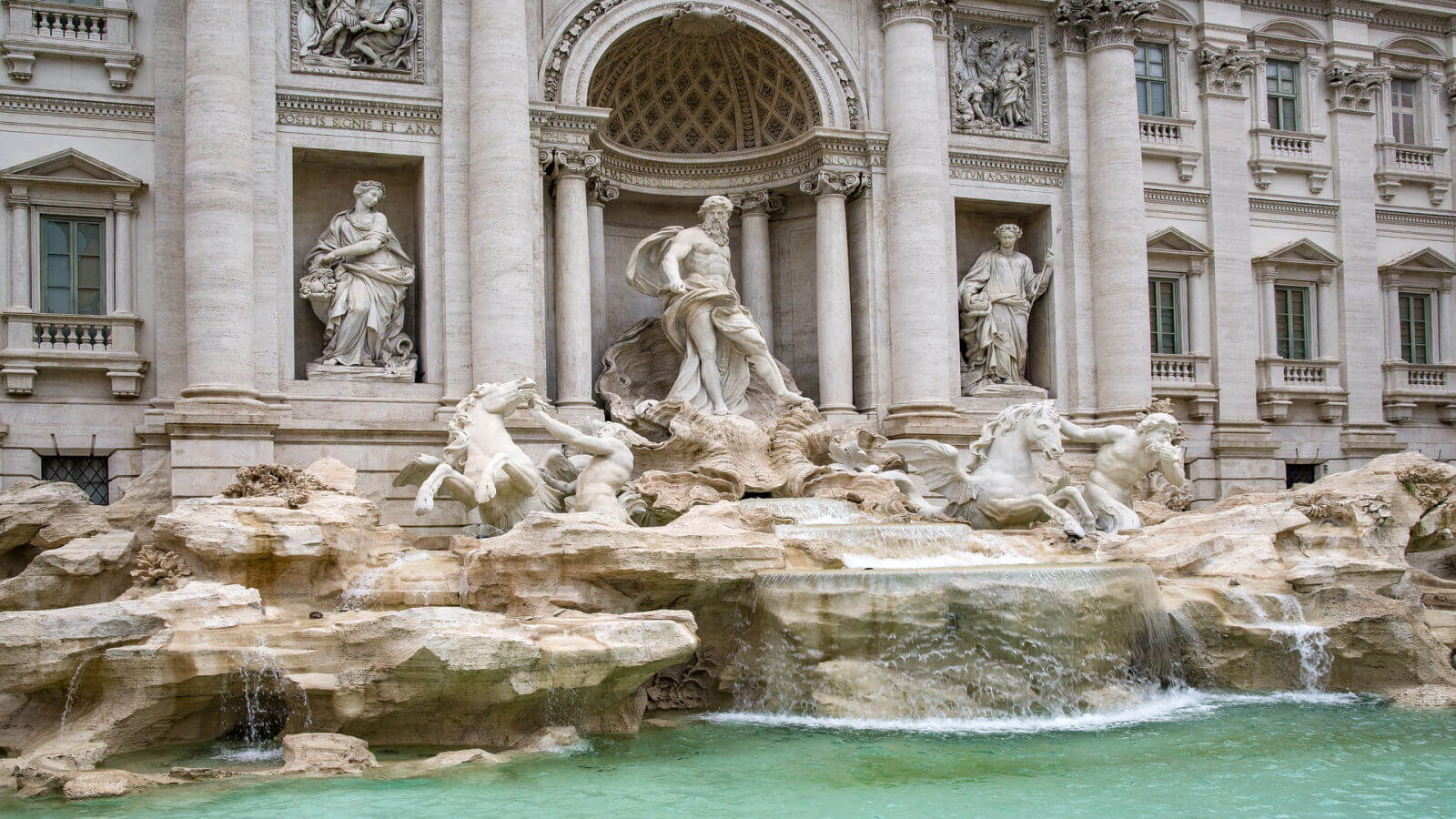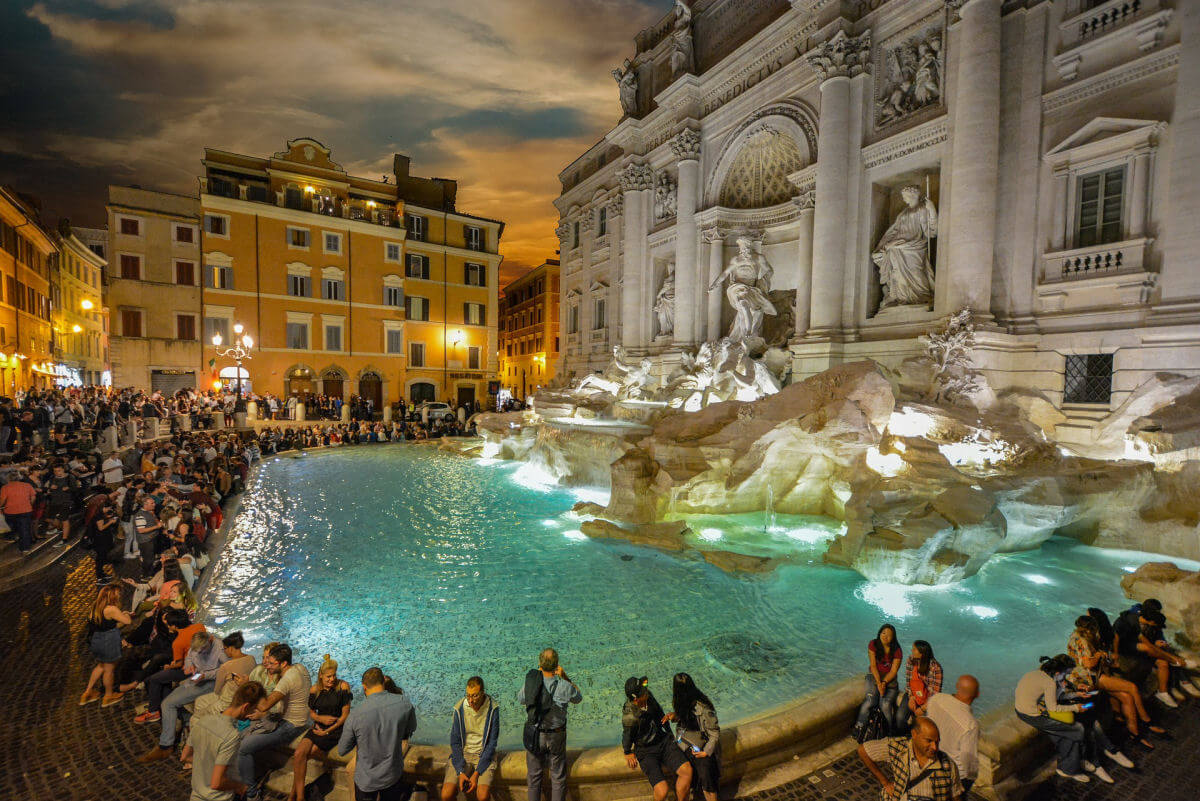
The Trevi Fountain, Fontana di Trevi in Italian, is the largest and most beautiful fountain in the city of Rome. At around 20 metres wide and 26 metres in height, this masterpiece of baroque architecture is, along with the Colosseum and the Vatican, one of the most iconic structures in the city, with people travelling from all over the world to see it.
History of the Trevi Fountain
The fountain gets its name from the Latin word Trivium (meaning an intersection of three streets), as the fountain is located at the intersection of the ancient roads of Via de Crocicchis, Via Poli and Via delle Muratte.
The Aqua Virgo Aqueduct
The Trevi Fountain has a rich history, dating all the way back to the time of ancient Rome. The origins of the fountain can be traced to 19 BC, where the location was the end point of the Aqua Virgo aqueduct.
This aqueduct, constructed by Marcus Vipsanius Agrippa during the reign of the emperor Augustus, was one of the eleven Roman aqueducts which supplied fresh water to Rome during the period of the Roman empire.
The Aqua Virgo brought water to the city from over 8 miles away. This water was often described as the best tasting water in all of Rome. According to a legend repeated by Frontinus, thirsty Roman soldiers asked a young girl for water, who directed them to the springs that later supplied the aqueduct. The Aqua Virgo was named after her.
At its peak it supplied 100,000,000 litres of water per day. This water was not only used for drinking, but also supplied the Baths of Agrippa, located in the Campus Martius (Field of Mars).
The Aqua Virgo has been so important to the city of Rome over the centuries regarding supplying drinking water to Rome that its successor, the Acqua Vergine, continues to be a source of fresh water to the city even to this day.
The Original Trevi Fountain
Many tourists are surprised to learn that the Trevi fountain they see today is not actually the original one. Construction on the current fountain was completed in 1762 (more on this later), but there have been at least two fountains in this location previously, although calling them “fountains” may be stretching the definition of the word, particularly when comparing them to what is there now.
In the year 1453, Pope Nicholas V initiated the renovation of the Aqua Virgo, as well as adding additional conduits to provide more areas and buildings in the city with water. Known from this point onwards as the Acqua Vergine, he commissioned a new fountain for its terminus, the present-day site of the Trevi Fountain.
This ‘fountain’ was nothing more than a simple wall monument with spigots; a humble beginning for what would eventually become one of the world’s most recognizable landmarks.
In 1629, Pope Urban VIII decided that the terminus of the Acqua Vergine aqueduct required a more dramatic mostra (showpiece). He commissioned Italian architect Gianlorenzo Bernini to replace this fountain with a grander monument, but only an undecorated basin was erected before the pope's death in 1644, although some of Bernini’s ideas and designs can be seen on the fountain today.
Pope Urban VIII’s death stopped the project in its tracks, and this remained the case for the next 90 years.
In 1732, Pope Clement XII announced a competition for the commission of a new fountain. Originally, Alessandro Maria Gaetano Galilei was selected as the winner. However, the result caused an outcry in Rome, as Galilei was from Florence (indeed, he was a descendant of one of Florence’s most famous inhabitants, the famous astronomer Galileo Galilei).
The citizens of Rome felt that ‘one of their own’ should be chosen to re-design the fountain. Their protests clearly worked, as the Roman Nicola Salvi was then chosen instead.
Work began in 1732, but Salvi died 19 years later in 1751, with the fountain still far from finished. Four different sculptors were then chosen to complete the project, and Giuseppe Pannini was appointed as chief architect.
The Trevi Fountain was finally completed in 1762, a full 30 years after construction began. It was officially opened and inaugurated on 22 May 1762 by Pope Clement XIII.
Design and Architecture
The fountain is an architectural masterpiece and is considered one of the most beautiful fountains in the world. It is designed in the traditional Baroque style, which is characterized by its ornate decoration, dramatic curves, and use of sculptures and statues.
The fountain is predominately made of travertine marble, which was quarried near the city of Tivoli, some 22 miles from the east of Rome, and is decorated with sculptures of sea horses, mermaids, and tritons. The central figure in the fountain is the statue of the Roman god Neptune, who is surrounded by other figures that symbolize the power of the sea. The fountain also features a small waterfall, which adds to its beauty and charm.
Symbolism and Legends
The fountain is steeped in symbolism and legends. The two horses on either side of Neptune represent the power of the sea, while the two tritons on either side of the horses symbolize the calm and rough seas.
The legend says that if you throw a coin into the fountain over your left shoulder with your right hand, you will return to Rome. This tradition started in the 1950s with the movie "Three Coins in the Fountain" and has since become a popular custom among visitors (read more on this in the “TV and Movie Appearances” and “Coin Throwing” sections below).
Restorations
The Trevi fountain has undergone several restorations over the years, the most significant ones in recent times taking place in the years 1988, 1998 and again in 2015, which also involved the installation of 100 LED lights to improve the spectacle of the fountain’s appearance at night.

In 2016, the Italian fashion house Fendi staged a show which was titled "Legends and Fairy Tales" at the Trevi fountain. The show involved a glass runway over the water to give the impression that the models were walking on water. Not only was this show to celebrate Fendi’s 90th anniversary of its founding, but the brand also gave over $2 million towards the restoration of the fountain.
External Link:
https://www.cntraveler.com/stories/2016-07-08/fendi-stages-a-fashion-show-at-romes-trevi-fountain
Movie Appearances
The Trevi fountain has made appearances in many TV shows and movies, helping greatly in making it a familiar and beloved landmark that is easily recognized by people all over the world, and making them want to jump on a plane and fly to Italy!
For example, the fountain was featured in the classic 1954 Hollywood film "Three Coins in the Fountain" which starred Dorothy McGuire, Jean Peters, and Louis Jourdan. The film tells the story of three American women working in Rome and their romantic adventures. The movie was a huge success and made the fountain a popular destination for tourists, as well as an enduring symbol of romance and adventure.
Probably the famous appearance of the Trevi fountain was in the romantic comedy "La Dolce Vita" directed by Federico Fellini in 1960. The film starred Marcello Mastroianni and Anita Ekberg, and it depicted the fountain as a symbol of the excesses and decadence of the high society in Rome.
Even those who have never watched the movie will probably have seen still pictures or clips of the scene where Ekberg and Mastroianni are in the fountain’s waters in full evening wear. If not, you can see the clip below:
In more recent years, the Trevi fountain has also made appearances in popular movies and TV shows such as "The Lizzie McGuire Movie", "Eat, Pray, Love", and the romantic comedy "To Rome with Love".
Coin Throwing
No article on the Trevi Fountain would be complete without a section on coin throwing.
The practice of throwing coins into the Trevi Fountain began in earnest after the release of the movie "Three Coins in the Fountain" in 1954. In the film, Frances (Dorothy McGuire) and Anita (Jean Peters) tell Maria (Maggie McNamara) that, according to legend, if she throws a coin into the fountain and makes a wish to return to Rome, then she will.
Nowadays, tourists who visit Rome throw a coin into the fountain so that one day they will return and be able to revisit the beautiful city. As mentioned earlier, coins are supposed to be thrown with your right hand over your left shoulder.
This tradition has become so popular that about €3,000 worth of coins are thrown into the fountain’s water every day. This significant amount of money is regularly collected up to prevent the fountain being clogged up with the sheer number of coins, and is nowadays given to charities and good causes.
Things to Keep in Mind When Visiting The Trevi Fountain Today
As mentioned earlier, the Trevi Fountain is one of the most visited tourist attractions in Rome, and indeed one of the most popular in the whole of Italy. As such, it can get quite crowded, particularly at peak times of the day, even more so during high season for holidaymakers in the summer months. If you can, try to get up early to get those spectacular photographs before too many tourists get in the way!
You are also likely to encounter rose sellers in the vicinity of the fountain, trying to make a few euros from visiting couples who come for the romance of the area, and will either be more receptive (or find it more difficult) to refuse buying a rose for their loved one who is standing right beside them! The rose sellers can be quite pushy, but just keep saying no politely but firmly, and they will soon move on to more potential customers who they may have more luck with.
Also, however tempting the clear blue water may look in the hot midday sun in August, it is strictly forbidden to get into the water at any time. There will be a policeman or two never far away from this popular tourist destination, and they will quickly pull you out and issue you with a €500 fine. Eating and drinking on the steps is also forbidden, and could land you the same monetary fine.
We said that the Trevi Fountain also has about €3,000 worth of coins thrown into its water every day... Needless to say, trying to steal these is also a crime which will land you in hot water, pardon the pun, with the local police.
And finally, please don’t be tempted to drink the water. It may once have been filled with water that the ancient Romans did drink and thought was the best tasting water in all of Rome, but their hygiene standards were a bit different to ours. The water in the fountain will not have been treated to make it safe and is not intended to be drunk.
Also, the ancient Romans did not fill the fountain with Denarii or other coins which pollute the water from the metal in the coins. Plus, if all that wasn’t enough to put you off, the water in the fountain these days is recirculated rather than continuously fed via an aqueduct, so it certainly won’t be fresh, healthy or taste very nice at all. So don’t do it!
Other Rome Attractions:
- Spanish Steps
- Sistine Chapel
- St. Peter's Basilica
- Castel Sant'Angelo
- Basilica of St. John Lateran
- Palazzo Venezia



